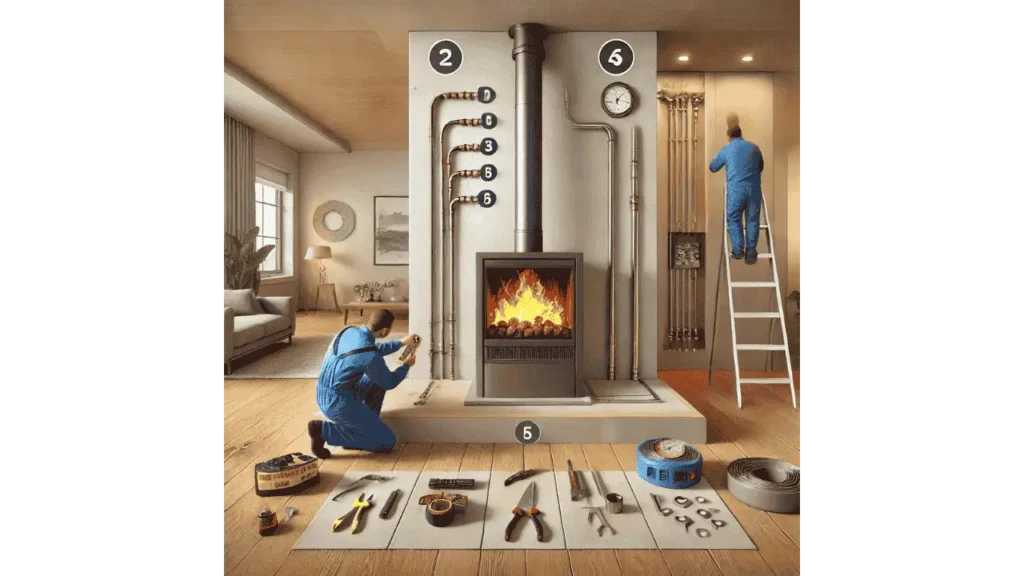Adding a gas line to your fireplace can feel overwhelming, especially with safety concerns and installation costs. I’ve been there, wondering how to get it done right without breaking the bank. The key is working with a professional to ensure everything is installed safely and efficiently. In this guide, we’ll cover who can help, the steps involved, costs, and tips for choosing the right gas line, so you can confidently upgrade your fireplace.
Installing Gas Lines For Your Indoor Fireplace
Adding a gas line to your indoor fireplace is a great way to enhance efficiency and convenience, but it’s not a DIY project for most people. It involves careful planning, precise installation, and adherence to safety codes to ensure everything runs smoothly. A professional plumber or gas technician is typically required to handle this process, as they have the expertise to safely connect the gas line and test the system. When I had a gas line installed for my fireplace, the peace of mind knowing it was done correctly was worth every penny. Let’s explore who can help and how the process works!
Who Installs a Gas Line?
A licensed plumber or certified gas technician is the best person to install a gas line for your fireplace. They have the training and experience to ensure the installation meets local safety codes and operates efficiently. Hiring a professional also reduces the risk of gas leaks or improper connections, which can lead to serious safety hazards. When I had my gas line installed, I worked with a certified technician who made sure everything was set up safely and walked me through how to use it properly.
How Do You Install a Gas Line for a Gas Fireplace?
Installing a gas line for a fireplace involves several steps that ensure safety and functionality. Each step must be performed carefully, often requiring professional expertise. Here’s a breakdown of the process:
Step 1 – Preparing to Install Your Gas Line
Before starting, assess your home’s gas system and the location of the fireplace. Determine the route for the gas line and ensure it complies with local building codes. During my installation, the technician carefully measured the distance and planned the least invasive path to minimize disruptions.
Learn More: Putting Glowing Embers on a Gas Fireplace!
Step 2 – Shut Off Gas Service
Turn off the gas supply to your home to prevent any accidents during the installation. This step is non-negotiable for safety. Professionals will double-check this to ensure no residual gas is left in the lines.
Step 3 – Install Gas Line into the Fireplace
The gas line is run from the main gas supply to the fireplace location. This involves cutting and fitting the pipe, which must be done with precision to avoid leaks. A licensed technician will secure the line and seal all joints, ensuring it’s properly anchored along the route.
Step 4 – Connect Fireplace Line to the Gas Pipe
Once the line is installed, it’s connected to the gas input of the fireplace. This step involves attaching fittings, testing for leaks, and ensuring the flow is properly regulated. When my technician did this, they used a leak-detection solution to confirm the connections were airtight.
Step 5 – Finishing Touch
After the gas line is connected and tested, the final steps involve securing the fireplace, reinstalling any removed panels, and restoring the gas supply. Professionals will relight your pilot light or ignition system and test the fireplace to confirm it’s working safely and efficiently.
How Much Does it Cost to Install a Gas Line to a Fireplace?
The cost to install a gas line for a fireplace typically ranges between $200 and $1,500, depending on factors like the distance from the main gas supply, local labor rates, and the complexity of the installation. For instance, running a line through walls or floors increases the cost due to additional materials and time. When I had mine installed, it cost about $800, which included a mid-length run and some minor adjustments to the gas system. Always get a detailed quote and ensure the technician is licensed for the job.
What Size Gas Line do I Need for a Gas Fireplace?
The size of the gas line depends on the fireplace’s BTU rating and the distance from the gas supply. Most gas fireplaces require a 1/2-inch or 3/4-inch diameter line to ensure proper gas flow. If the line is too small, it can restrict the supply and affect performance. A professional will calculate the appropriate size based on your fireplace’s requirements and the layout of your home.
Can I Use a Flexible Gas Line for a Fireplace?
Yes, flexible gas lines (corrugated stainless steel tubing or CSST) can be used for fireplaces, offering easier installation around tight spaces. However, they must meet safety standards and be installed correctly to prevent leaks. I’ve seen how flexible lines can simplify the process, but ensuring they’re properly secured and inspected is critical for safety and longevity.
Bottom Line
Installing a gas line for your fireplace is a safe and efficient way to enhance your home’s heating. While the process requires professional expertise and careful planning, it’s well worth the investment for the convenience and reliability of a gas fireplace. With the right setup, you can enjoy consistent warmth and peace of mind for years to come.
- 27 Farmhouse Fireplace Ideas That Bring Warmth & Charm - August 18, 2025
- 25 Fireplace Lighting Ideas to Illuminate Your Hearth - August 7, 2025
- How to Replace an Electric Fireplace Switch? - August 5, 2025



